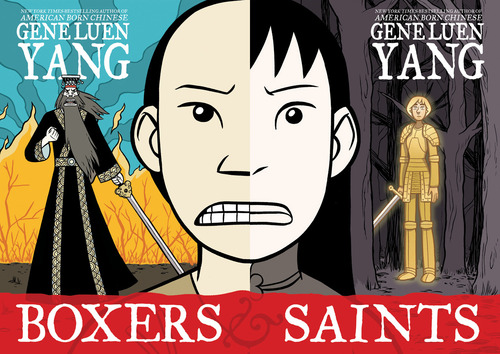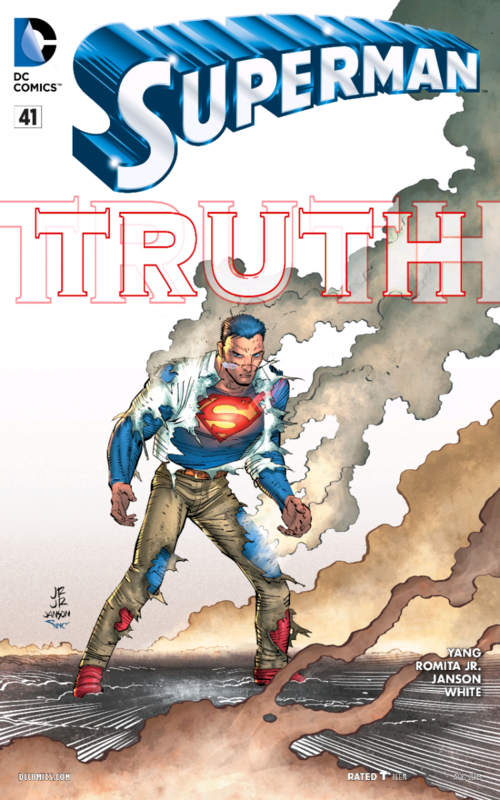Page One, Panel One: Researching & Hunting for Ideas with Gene Luen Yang
Comics Features Gene Luen YangPage One, Panel One features in-depth discussions between comic writer Van Jensen (The Flash, Pinocchio, Vampire Slayer) and other scribes diving into the creative process behind the medium. This week’s conversation features Gene Luen Yang, a writer and cartoonist who established himself as a prominent voice in comics with his 2006 graphic novel, American Born Chinese, which was a finalist for the National Book Award and also took home an Eisner that year for Best New Graphic Album.

The writer and artist has since gone on to create a host of acclaimed books the celebrate diversity and Yang’s heritage, including the historical epic Boxers & Saints and pulp reinvention, The Shadow Hero with artist Sonny Liew. Yang recently took over as writer of Superman with issue 41, joining series artist John Romita Jr.
While Yang mostly works in genre fiction, his stories often stem from reality and history. Jensen sat down with the creator to discuss researching projects, the challenges of writing an icon like Superman and living the sacred life of a writer.![]()
Van Jensen: We’re talking about research, and I thought of this topic for you specifically because though you don’t write nonfiction, I’ve always seen your work as having this very real feel to it. There are books like Boxers & Saints, of course, that are historically based. But even Shadow Hero and American Born Chinese felt like a lot of work was done to ground them in a specific time and place. And for me, as a journalist, that really drew me to your writing. So, is that a fair characterization? Do you think of yourself as a writer who works in that style?
Gene Luen Yang: I’ve been doing more and more research. In Story, Robert McKee talks about three kinds of research: memory, imagination and books. For American Born Chinese, my first graphic novel with First Second Books, I did mostly “memory” research. It’s fiction, but I pulled heavily from my own childhood.
Jensen: Very interesting. I’d forgotten that bit of Story. I’m due for a re-read, it seems.
Yang: Boxers & Saints, which I did six years later, was my first project that required lots and lots of “books” research. And honestly, I loved it. It was nerve wracking, too—I never felt like I was done. But it added so much depth to the process. My next big project is nonfiction, actually. I’m doing tons of “books” research for that.
Jensen: How have you changed how you go about preparing for this nonfiction project? How do you split the focus for gathering information vs. gathering visual reference?
Yang: With my nonfiction project, I am just feeling my way around. I feel like I’m in a room with all the lights off. I read a book about creative nonfiction. But I’m really in the heat of it. I feel like I’m only going to end up using 20 percent of what I’ve gathered.
Jensen: Prior to working in comics, had you ever had a job that required research? Or was it a significant part of your college experience? Was that part of your life as a teacher?
Yang: No, I never worked a job that required research. I’m not really good at it, to be honest. I’m still learning. I was a computer science major. I worked as a programmer and then as a high school computer science teacher.

Boxers & Saints Cover Art by Gene Luen Yang
Jensen: Was there a moment or experience that showed you the power of research, or if it’s something that just naturally developed as you progressed into creating stories?
Yang: I don’t know if there was a specific moment where I realized the power of this… but I did eventually realize creativity doesn’t mean creating something out of nothing. Creativity requires input, and that’s what research is. You’re gathering material with which to build.
So you were a journalist? Are you still?
Jensen: I went to college for it and was active with the college newspaper. It was a daily, with like 100 employees. After college I worked as a crime reporter, then a magazine editor. I sort of retired from it last year to focus on writing, though I still do some freelancing, mostly to keep those muscles in shape. I think it’s helped me more in terms of work ethic, but I did come into creative writing with a mindset of accumulating a lot of information on the front end. That information just varies wildly, project to project.
Yang: Do you feel like any of your journalism experience carries over to your writing?
Jensen: Without question. Being a reporter means being a good listener, so you get an ear for speaking patterns, which helps with dialogue. The research training helps a lot, too. But mostly the biggest thing is the work ethic. I can script really, really fast if I need to, which is all from that daily deadline training.
So, back to your process. With Boxers & Saints, what was your approach as you began to develop the story? Where did you look for information? How did you decide what bits of history to include, and which ones were superfluous?
Yang: For Boxers & Saints, I started by reading a couple of articles on the Internet, then writing a really rough outline, then getting more hardcore into the research. I went to a university library once a week for a year, year and a half. I looked on AbeBooks for out-of-print books about turn-of-the-century China.
Jensen: Have you ever had a bit of research that came late in the game and really changed the project, whether affecting the plot or a character?
Yang: The research changed the shape of that story. The final book is nothing like my original outline. There were times when I really, really hoped history would be one way, but then I’d research and it’d end up being another. I just had to adapt.

Superman #41 Cover Art by John Romita Jr.
Jensen: Now that you’re on Superman, how did you prepare for that gig? When I started out, I felt like it was a challenge to balance doing my own thing and really respecting all that came before, when it came to mainstream superhero comics. Is that something you’ve felt at all?
Yang: Um, YES.
Jensen: Ha! Good to know I’m not alone. How did the launch [in June] go?
Yang: The Superman launch went well. I did a signing at Flying Colors with Joe Field. That dude is my hero. Have you met him?
Jensen: I haven’t, unfortunately.
Yang: I still feel like I can’t catch my breath, though. Man, how long have you been doing monthlies?
Jensen: Three years, I guess. The production cycle is so intense. You don’t really understand it until you’re living it. The gig is so much harder than anyone realizes.
I know I had a pretty short turn around when I did my first superhero gig. But then I later went back and read through mountains of Green Lantern comics. Had you already read a lot of Superman? Have you been going back through some of the older issues?
Yang: I’ve been reading old Superman comics. As soon as I got the job, I read the first few issues of Action Comics. I also read this excellent book called Superman: The Unauthorized Biography by Glen Weldon.
Jensen: That’s on my to-read list. Have you found some old characters or concepts that you want to bring back? Superman with a mullet, maybe?
Yang: So far, I’ve brought back one character—an arms dealer named Norvell who originally showed up in Action Comics #2/Superman #1. Superman’s such an old character with such a rich history. He’s incredibly flexible. I hope what I write will resonate with at least a piece of what came before.
Jensen: That’s a key challenge of the job, for sure. But I’m really excited to see what you do with it.
What advice would you give to young writers? What advice do you wish you’d heard as you were starting out?
Yang: I always tell aspiring writers to work on their lifestyle, their habits. Create a life that allows for writing time. Set aside a chunk of time every week or every day to write. Stick to it. Make it sacred. Quality comes from practice.